|
“Adjusting Your Pelvic Tilt”
now that is a funny name even for a rehab article. Honestly it sounds like something you would do to your car. I bet for the
most part a lot of you don’t even know what a pelvic tilt is. Some of you may even have pelvic tilts and don’t
even realize it.
What
is a pelvic tilt? A pelvic tilt is actually a fairly common posture problem. A pelvic tilt occurs when the pelvis tilts in
one direction. There are two main types of pelvic tilts. There is the anterior pelvic tilt and the posterior pelvic tilt.
An anterior pelvic tilt is when the pelvis tilts towards the front of the body. This is the more common of the two types of
tilts. A posterior pelvic tilt is when the pelvis tilts towards the back of the body. Although this type of tilt is not as
common, over time it can become a problem.
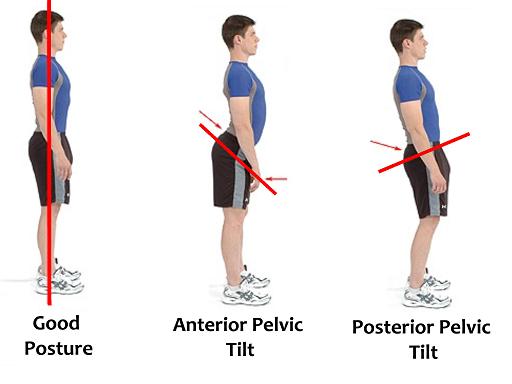
Today however we are going to focus mainly on the issues of an anterior
pelvic tilt. Right now you’re probably saying “Well if I have this tilt and don’t even know it, what’s
the big deal?” Well better pelvic alignment means better posture, better
lifts, better athletic performances, and fewer injuries. What if I told you some of your fitness related problems are probably
because of your pelvic tilt?
Is squatting problematic for you because you feel it way too much in the
lower back?
Do you tend to lean way to far forward when squatting?
Do you have trouble with the lockout on your deadlift and arch your back
to complete it?
Do you tend to get a lot of hamstring strains or pulls?
Do you often have lower back pain?
Is direct hamstring work problematic for you because they tighten up too
quickly?
Do you often have calf cramps or shin splints?
All of these problems can and may be attributed to a pelvic tilt.
Testing your tilt-
Here are two relatively simple test to test the severity of your pelvic
tilt.
The Duct Tape Test-
Test: Grab a roll of duct tape,
and take your shirt off. Tense up your abs as hard as you can, and wrap a single layer of duct tape around your waist (snug),
right across your hip bones. Now relax your abs. What did the tape do? If it expanded straight out, your tilt is fine. You
may need to loose a few pounds but the good news is you don’t have a tilt! If the angle of the tape took a dive towards
the ground, looks like you have some work to do. The limitation with this test is, if you’re fairly fat in the midsection
this probably won’t work quite as well. However, if you’re fairly fat in the midsection, you most likely have
an anterior pelvic tilt anyways.
The Wall Test-
Simple, lean up against a wall
(Now you know where the test gets it’s name from). Walk your feet out about a foot or so and keep your weight even from
heel to toe. Your head, shoulders and butt should make contact with the wall while staying fairly relaxed. Now, have a partner
see what they can fit between the wall and your lower back. If they can fit a couple knuckles of their hand, you’re
good. If they can fit something fairly large, like a rolled up magazine you’re going to need to do some work.
Pelvic tilts are due mostly to muscle imbalances. Certain muscles are not
working or firing properly and other muscles have to pick up the slack. By strengthening and stretching the muscles that will
promote posture opposite of your anterior tilt, you can improve your ability to function. In other words start building and
stretching muscles that would cause you to stand more upright. Start building a “posterior tilt” so to speak.
Let us now look at some of the muscles involved in an anterior pelvic tilt.
The Hip Flexors-
There are two main hip flexor muscles involved in an anterior pelvic tilt.
, T he two muscles are called the Iliacus and Psoas
muscles. When these two muscles become tight
and overactive, they pull on the top of the pelvis and the lumbar spine. This pulling is what brings the pelvis forward causing
the tilt.
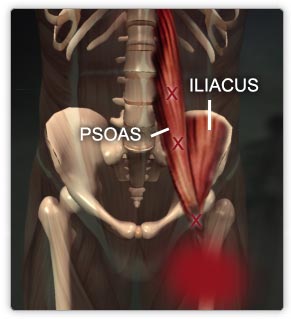
The Glutes-
The glutes also known as the good old buttocks, is also a very important group
muscles involved in the pelvic tilt. The glutes make up the back part of the pelvic hip complex. When the glutes are underactive
and not tight, this is when the hip flexors become overworked because they have to compensate for the weak glutes. This sometimes
is also a key factor in lower back pain.
The Spinal Erectors-
You can call the spinal erectors the support beams of the posterior chain.
Well developed and strong spinal erectors keep the back upright and stable. When the body has an anterior pelvic tilt, the
spinal erectors become shortened in length. When the spinal erectors shorten, the abdominals now have to carry a lot of the
load in turn pulling on the pelvis.
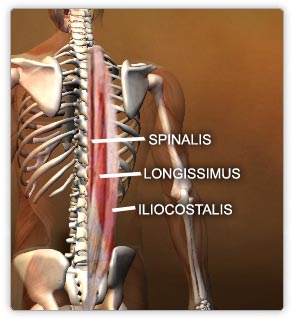
The Hamstrings-
With a pelvic tilt the hamstring muscles become shorter. When this happens
a person becomes quad dominate. More quad dominance and shorter hams typically result in more hamstring injuries because the
hams are weaker.
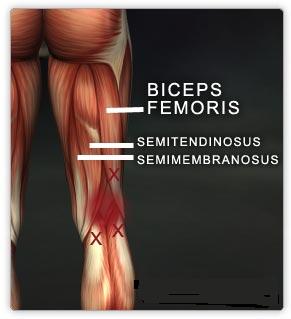
The Abdominals-
While the spinal erectors are the support beams for the back of the body,
the abdominals are the support beam for the front of the body. When the “back support beams” become weak the abdominals
take on the job of being the support beams of the front and back.
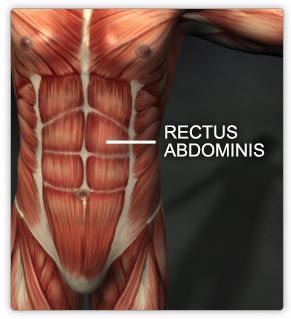
Creating Balance-
Now that we know some of the key muscles involved in a anterior pelvic tilt. Lets look at how the muscles are affected
and how to fix the effects.
 |
 |
|
Anterior Pelvic Tilt |
|
Muscles Involved |
Cause |
Fix |
|
Hip Flexors |
Become tight and overused-
Pull down the pelvis and lumbar spine |
Stretch |
|
Glutes |
Underused and elongated , the hip flexors take over the work pulling everything forward
|
Direct glute work and muscle strengthening |
|
Spinal Erectors |
They become shortened from being weak and underused causing the abs to take over |
Direct muscle strengthening, endurance building, and stretching |
|
Hamstrings |
Become tighter and shorter causing a forward lean and the quads to do more work |
Muscle strengthening and muscle building stretching |
|
Abdominals |
Become tight and overused from compensating for the spinal errectors |
Build endurance and strength especially in the Rectus Abdominals and Obliques |
|
|
 |
 |
Exercises and Stretches-
While some muscles involved will need direct strengthening and muscle building some muscles involved will just need
some good old stretching and loosing. Getting massages and using a foam roller will do you a world of benefits. If you don’t
have a foam roller you could just as easily use a tennis ball in some instances. Just be sure to use both static and dynamic
stretching techniques to loosen some muscles. While static stretching will be good for stretching and loosening muscles, dynamic
stretching will be more beneficial just before athletic and explosive movement events.
 |
 |
|
Anterior Pelvic Tilt Fix Chart |
|
Muscles |
Exercise |
Stretch |
Dynamic Stretch |
|
Hip Flexors |
|
Static Hip Flexor Stretch |
*Running Butt Kicks
*Walking Lunges |
|
Glutes |
*Barbell Glute Bridges
*Glute Kickbacks
*Glute Ham Raisers |
Glute Bridges |
Walking High Knees |
|
Spinal Erectors |
|
Superman Exercise
|
*Walking Straight Leg Kicks
*Toe Touches |
|
Hamstrings |
*Stiff Leg Deadlifts
*5 sec. Lying Leg Curls |
Toe Touches |
Walking High Knee Lunges |
|
Abdominals (obliques and rectus abdominals) |
*Barbell Front Squat Static Holds
*Suitcase Lift (One Arm Deadlifts)
*Weighted Reverse Crunches |
|
|
|
|
 |
 |
Today we looked at the anterior pelvic tilt and the effects it could have on your body. If you have and anterior pelvic
tilt and are not working to improve it, you’re doing yourself more harm than good.
Not only are pelvic tilts bad for your posture but places undue stress on muscles and joints. This can lead you down
a road of many problems. Your problems can range from slightly diminished performance in the weight room all the way to long
term deliberating muscle and joint damage. With a few exercises and stretching you can help correct your tilt for a more functional
stronger you.
*Disclaimer- This information in this article is not meant to treat, diagnose, prescribe or cure any
ailment. Always consult a physician before you begin any new exercise program, start, stop, or change anything that has been
previously prescribed...
|

